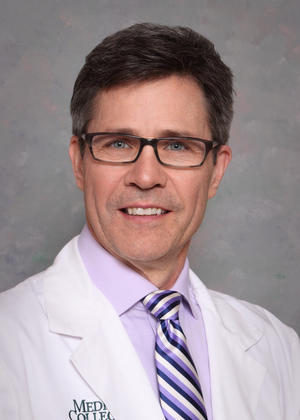“We’re experts in the diagnosis, pathophysiology, and management of any disabling condition,” explained John McGuire, MD, physical medicine and rehabilitation (PM&R) specialist and Director of Stroke Rehabilitation & Spasticity Management at Froedtert Medical College of Wisconsin.
PM&R physicians evaluate and treat patients with physical and cognitive impairments resulting from musculoskeletal conditions (neck or back pain, or injury), neurological conditions (stroke, brain injury, or spinal cord injury), and other medical conditions. “We approach all these conditions in the same light,” said Dr. McGuire, “as far as asking, what are your deficits and how can we get you as functional as possible?”
PM&R physicians are also known as physiatrists. Some in the field avoid using this term due to the frequent confusion with psychiatrists and psychiatry.
The field of PM&R emerged after World War I and World War II in response to hundreds of thousands of soldiers returning from service with brain injuries, spinal cord injuries, amputations, and other traumatic injuries. Dr. McGuire explained: “Basically the surgeon would piece them back together and now they have to figure out how are they going to dress themselves, feed themselves, walk, and get back to work and doing the things they need to do. Our goal is to improve function and reduce pain, basically a non-surgical approach to overall well-being that goes beyond the medical model. It’s more of a holistic approach to all the ways that someone’s life is impacted by a condition or injury.”
PM&R physicians practice in a number of clinical settings. Subspecialties range from brain injury and spinal cord injury to sports medicine, pediatric rehabilitation, and more. PM&R physicians typically work in an interdisciplinary fashion with physical therapists, occupational therapists, speech therapists, and other supportive therapies depending on the needs of patients.
When assessing a patient, careful consideration is made to overall wellness. Dr. McGuire explained: “Whatever ails you, if you’re not eating right, sleeping right, if you’re not exercising, no matter what your problem is, that’s going to create more problems. We have to look at everything to get your life back together.”

John McGuire, MD is a physical medicine and rehabilitation specialist at Froedtert Medical College of Wisconsin
Dr. McGuire was trained in stroke rehabilitation and electro–myography (EMG). He was an early leader in the therapeutic use of botulinum neurotoxin and intrathecal baclofen. This exposed him to patients with dystonia and spasticity resulting from stroke, cerebral palsy, and other conditions. “I love working with my movement disorders colleagues. We all work together,” said Dr. McGuire. “If a patient turns out to be more in the dystonia sphere, I may send them to the neurologist; if the patient is more in the spasticity sphere, they may send them to me. There’s this cross fertilization with all these patients.”
The nature of PM&R requires keen understanding of human anatomy and body mechanics. However, McGuire stressed that not all PM&R physicians can be expected to treat movement disorders. Credentials that lend PM&R physicians to expertise in dystonia and movement disorders include certification in electrodiagnostic medicine (EMG) and advanced training in neurorehabilitation. A small number of medical institutions offer advanced fellowship training for PM&R physicians specifically in movement disorders neurorehabilitation.
The DMRF Canada offers a Find a Doctor directory.
Thank you to Dystonia Medical Research Foundation (USA) for allowing us to share this information. The DMRF is a 501(c)(3) non-profit organization dedicated to advancing research for improved dystonia treatments and ultimately a cure, promoting awareness, and supporting the well-being of affected individuals and families.
